HELLFIRE is an air-to-ground missile system designed to defeat tanks and other individual targets while minimizing the exposure of the launch vehicle to enemy fire. HELLFIRE uses laser guidance and is designed to accept other guidance packages. It is used on helicopters against heavily armored vehicles at longer standoff distances than any other Army missiles now in the inventory. The HELLFIRE II is the optimized version of the laser family of HELLFIRE missiles. The Longbow HELLFIRE Modular Missile System is an air-launched, radar aided, inertially guided missile that utilizes millimeter wave radar technology.
Current launch platforms include the AH-64 APACHE helicopter and the Navy AH-1W. The system is also qualified for use on the UH-60 BLACKHAWK, and has been tested for use on the High Mobility Multipurpose Wheeled Vehicle (HMMWV) and the Improved TOW Vehicle (ITV). Prime contractors for the system are Rockwell International Corporation and Martin Marietta Corporation. The cost per missile is about $58,000. Sweden uses the HELLFIRE for coastal defense, and both Israel and Egypt have purchased the system.
The first shots of Operation Desert Storm occurred on 17 January 1991 when eight APACHE helicopters used HELLFIRE missiles and HYDRA-70 rockets to destroy two Iraqi early-warning ground control radar sites. However, this was not the first time that HELLFIRE missiles had been fired in combat. Over a year before, U.S. Army troops successfully used HELLFIRE against seven targets during Operation Just Cause in Panama.
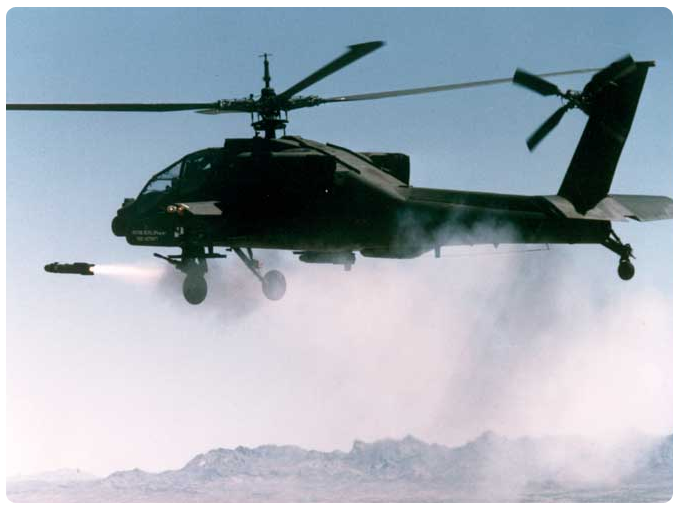
See more HELLFIRE photos
|
The Ground/Vehicular Laser Locator Designator (G/VLLD) was used for designating moving or stationary targets for use with laser-homing weapons such as HELLFIRE. The G/VLLD could also provide accurate target information for use with conventional artillery. The system was issued to selected field artillery battalions, tank battalions, armored cavalry units, and selected infantry units. Hughes Aircraft Corporation and Optic Electronic Corporation, prime contractors for the system, manufactured the G/VLLD at a unit cost $164,485.
System Chronology
November 66 The Laser Missile Systems Branch was organized in the MICOM Lab. Its mission was to research and develop an Army tactical weapon system employing laser devices. Exploratory development of laser semiactive systems had been ongoing since 1963. 1967 Hughes Aircraft Company and Martin Marietta completed system studies for a laser semiactive missile (LASAM). Both contractors concluded that the LASAM was technologically feasible within the existing state of the art. June 67 The Office, Chief of Research and Development requested the submission of a revised laser semiactive program plan and the formulation of an electro-optical program plan. AMC specified that the plans be directed toward an in-house advanced development program. To carry out the latter concept, 42 more people were detailed to the Laser Missile Systems Branch effective 1 July 67. September 67 The Laser Missile Systems Branch was reduced in size and scope, and its funds were cut. March 68 The Combat Developments Command (CDC) approved the Advanced Development Objective and Qualitative Materiel Development Objective for the Missile System, Target Illuminator Controlled (MISTIC), formerly called LASAM. Higher headquarters did not approve this program. April 68 The Laser Missile Systems Branch was disbanded and management responsibility for the MISTIC program was transferred to the Advanced Systems Laboratory. The latter's primary objective was to fulfill the DOD prerequisites for initiating contract definition for a direct/indirect fire, antitank/assault weapon. Its secondary objective was to advance the state of the art in laser semiactive guidance and optical contrast seeker guidance technology to make these techniques available for application to other weapon roles. The low funding priority for MISTIC continued through FY 71. March-April 69 After being zero funded for the first three quarters of FY 69, a MISTIC system engineer was appointed and funding was received. July-October 69 A special task group in the MICOM Lab concentrated on defining and synthesizing an antitank weapon. MISTIC was one of the concepts. November 69 The MISTIC concept, proposed for the over-the-hill fire capability, was presented to the Office, Chief of Research and Development, but the system was not approved for advanced development. January 70 A flight demonstration program was directed to test missiles using various seeker heads. Both helicopter and fixed (tower mounted) launchers were also under consideration. 1971 The MISTIC advanced development program was zero funded, but the Assistant Secretary of the Army for Research and Development established a new initiative in terminal homing to start in FY 72. The new program was first titled Heliborne, Laser, Fire and Forget Missile, but the name subsequently changed to Helicopter Launched, Fire and Forget Missile (HELLFIRE). February 72 Congress released HELLFIRE program funds. DA directed the HELLFIRE effort to include a military potential test. April 72 The ground laser locator designator (GLLD) entered advanced development. Competitive contracts were awarded to Hughes Aircraft Company and International Laser Systems, Inc. Each contractor would develop and deliver two prototype models to be evaluated through developer technical tests and user agency operational tests. October 72 The MICOM Lab competitively evaluated Army, Navy, and Air Force candidate seekers. Contractor flight tests were conducted at Eglin Air Force Base (AFB), Florida. 11 December 72 MICOM permanently established the HELLFIRE Project Office. The Heliborne Laser Fire and Forget missile program resulted from the Army's requirement to develop a helicopter-launched, direct/indirect fire and forget, laser semiactive guided, terminal homing, antitank, hard point weapon system. One of the key components of the new system was its laser seeker device. 29 December 72 DA approved the Material Need document for the HELLFIRE weapon system. 1973 HELLFIRE was officially offered for tri-service use. April 73 Bell Aerospace Corporation and Philco Ford Corporation received competitive advanced development contracts for the airborne laser locator designator (ALLD). These contracts were modified in September 73 to include an additional ALLD prototype model from each contractor. 5 July 73 MICOM established the GLLD/ALLD Management Office (Provisional) to coordinate planning as well as to direct and control work and resources for these systems. November 73 After a substantial cost overrun was projected at mid-contract, the Bell Aerospace Corporation contract for the ALLD program was terminated. 21 December 73 The Office, Chief of Research and Development directed that the HELLFIRE program be reoriented by placing it into accelerated advanced development to resolve various operational uncertainties. The reoriented program required the user to conduct operational tests (OTs) of the system. Development test (DT)/OT hardware was needed. March 74 Rockwell International Corporation received a $1.2 million letter contract for the advanced development procurement of laser HELLFIRE hardware for use in the operational and technical testing program. April 74 Hughes Aircraft Company was awarded an engineering development contract for the GLLD. 11 April 74 The GLLD/ALLD Management Office (Provisional) was redesignated as the Office of the Product Manager, Precision Laser Designators (PLD). May 74 The Philco Ford Corporation delivered the first advanced development ALLD unit. June 74 MICOM awarded competitive 12-month contracts to Rockwell International Corporation & Hughes Aircraft Company for advanced development of the HELLFIRE modular missile. 9 January 75 The Assistant Secretary of the Army for Research, Development, and Acquisition announced the redirection of the HELLFIRE program. No more RDTE funds were available for the air defense suppression missile. Increased emphasis was placed on alternative guidance systems for the modular HELLFIRE. March 75 The tri-service Joint Development Plan for Ground Laser Designators (GLDs) was approved by all of the armed services. 25 March 75 The Air Force, which had been assigned as the executive service for the engineering development of the laser seeker, awarded an engineering development contract to Rockwell International Corporation. June 75 Philco Ford Corporation delivered the final ALLD unit. March 76 The Deputy Commander for Materiel Development, DARCOM, decided that the Precision Laser Designator (PLD) would continue as a product office, but he requested a review and update of the charter, which would be forwarded to DARCOM for approval. 30 March 76 The Deputy Secretary of Defense authorized the full-scale engineering development of the laser HELLFIRE. It was also decided to arm the Advanced Attack Helicopter (AAH) with the HELLFIRE. 30 June 76 Both Rockwell International Corporation and Hughes Aircraft Company delivered HELLFIRE prototype hardware. September 76 DARCOM decided to restructure the management of the GLD programs. The PLD Product Office became the single Army focal point for these programs. September 76 The PLD Product Office was notified that its mission was being expanded to include the Lightweight Laser Designator (LWLD) and the Modular Universal Laser Equipment (MULE). Responsibility for the Airborne Target Acquisition Fire Control System (ATAFCS), formerly known as the ALLD, would be transferred to another MICOM element. The PLD Product Office would also be upgraded to a project office and renamed. October 76 The ATAFCS was transferred from the PLD Product Office to the Technology Laboratory. It was also relegated to use solely in testing. DOD replaced ATAFCS with the Target Acquisition Designation System (TADS), which was being developed by the U.S. Army Aviation Research and Development Command (AVRADCOM). October 76 As part of the restructuring of GLD program management, DARCOM directed the U.S. Army Electronics Command (ECOM) to divest itself of all GLD engineering development. The MULE and LWLD, the latter renamed the laser target designator (LTD), were transferred to the PLD Product Office. 8 October 76 Rockwell International Corporation initiated effort under the HELLFIRE engineering development contract. 13 October 76 The U.S. Army Missile Research and Development Command (MIRADCOM) was tasked to develop the capability to clearly relate laser designator performance to weapon system probability of hit. A board of directors, which included the HELLFIRE Project Manager (PM), managed the effort to develop the laser designator/weapon system simulation (LDWSS). 12 November 76 The Deputy Secretary of Defense approved the HELLFIRE Modular Missile System (HMMS) Decision Coordinating Paper No. 118, which designated HELLFIRE as the point target subsystem for the AAH. 26 November 76 DA approved the letter of agreement for a fire and forget antitank missile system for Army helicopters. Higher headquarters also supported the advanced development of a terminal homing infrared type seeker to be used on the HMMS. April 77 Hughes Aircraft Company was awarded the engineering development contract for the MULE. July 77 It was decided to convert the PLD Product Office to the GLD Project Office. The new organization's charter was approved on 31 August 77. August 77 The LTD in-process review approved a limited production decision. This action was taken as a result of Congressional concern about duplication in design as well as to provide the designated capability while the MULE was being developed and tested. 9 September 77 Martin Marietta received two new contracts for the low cost alternative laser seeker (LOCALS). 4 January 78 The Air Munitions Requirements and Development Committee approved the Joint Services Operational Requirement (JSOR) for the HELLFIRE. The Army was designated as the lead development service for the system April 78 MICOM awarded a contract to Hughes Aircraft for limited production of the LTD. 25 September 78 The first programmed HELLFIRE missile was fired at Redstone Arsenal. December 78 The MIRADCOM Commander selected the Martin Marietta LOCALS as the HELLFIRE laser seeker. The Air Force subsequently canceled the 25 March 75 contract with Rockwell International Corporation. 19 March 79 The GLLD was type classified as Standard. 30 March 79 Hughes Aircraft Company received the first GLLD production contract. June 79 DA decided that the Army did not need the LTD, so the second buy was canceled. July 79 MICOM initiated the concept design effort for the Ground Launched HELLFIRE (GLH) missile, which would be fully integrated into various vehicles. October 79 The development effort began to adapt the GLLD for use under armor in the Fire Support Team/Vehicle (FIST/V). 1 October 79 The HELLFIRE & GLD Project Offices were formally merged into the HELLFIRE/GLD Project Office. February 80 Hughes Aircraft Company delivered the first MULE engineering development unit. The delivery of 10 units under the contract was completed in September 80. March 80 The design study of the GLH in a totally integrated vehicle concept was completed. April-June 80 Operational tests on the HELLFIRE missile were conducted at Hunter-Liggett Military Reservation, California. 10 February 81 It was decided to cancel the fire and forget seeker (the adaptation of the imaging infrared seeker to the HELLFIRE missile) full-scale development program primarily because of cost and aircraft integration concerns. March 81 The final LTD units were delivered. 25 February 82 Martin Marietta received a contract for the initial production of HELLFIRE laser seekers. 29 March 82 HELLFIRE was approved for full-scale production. 31 March 82 Rockwell International Corporation was awarded a contract for the first production buy of HELLFIRE launchers and missiles. 5 April 82 The MICOM Commander approved the full release of the LTD. 30 April 82 Rockwell International Corporation received a contract for the development and qualification of a minimum smoke motor to eliminate the firing signature of the HELLFIRE missile, thereby increasing system survivability. 7 June 82 The MICOM Commander approved the full release of the GLLD. July 82 The 82d Airborne Division, Fort Bragg, North Carolina, became the first unit equipped with GLLDs and COPPERHEAD training rounds. July 82 The engineering development contract was awarded for the modification of the HELLFIRE autopilot to improve the missile's capability in low visibility conditions. This effort was designed to cause the missile to fly a more direct trajectory from the launch aircraft to the target during periods of adequate horizontal visibility and low ceiling. July 82 The LTD was first fielded to the 18th Airborne Corps, Fort Bragg. November 82 The GLLD/COPPERHEAD was fielded to the initial operational capability (IOC) unit, the 24th Mechanized Infantry Division (ID), Fort Stewart, Georgia. 19 November 82 The U.S. Army Test and Evaluation Command (TECOM) successfully completed the FISTV-G/VLLD prototype qualification test program. March 83 The final fielding of the LTD was made to Fort Lewis, Washington. 15 July 83 The first MULE production contract was awarded to Hughes Aircraft Company. 22 September 83 NATO interoperability tests using the HELLFIRE missile system were successfully conducted in Norway. This was significant because these tests showed that the HELLFIRE was compatible with other NATO platforms and designators. They also illustrated that HELLFIRE integration into other launch aircraft could be accomplished quickly and easily. It was also the second time that the HELLFIRE system was tested on foreign soil in cooperation with NATO and other allied powers. 1984 The Office of the Secretary of Defense (OSD) granted an exception to the National Disclosure Policy to allow the HELLFIRE to be adapted to meet Swedish coastal defense needs. A lease agreement was initiated by Sweden for use of GLLD equipment in a feasibility study of coastal defense using the HELLFIRE system. 22 June 84 The MICOM Commander approved the full release of the G/VLLD. 28 August 84 The first joint firing of a HELLFIRE missile was conducted at Yuma Proving Ground. The crew of an OH-58D KIOWA WARRIOR located the target with the helicopter's laser and an AH-64A APACHE gunner fired a live warhead HELLFIRE missile, which hit directly on the target. 20 September 84 Fielding of the first increment of G/VLLDs to the U.S. Army, Europe (USAREUR) began. This action was completed on 26 October. May 85 The first U.S. Army Training and Doctrine (TRADOC) unit was equipped with the HELLFIRE as scheduled. By year's end, TRADOC had received all of its HELLFIRE equipment, repair parts, and technical publications. 31 October 85 The final G/VLLD procurement was awarded as an option to the Hughes Aircraft contract. November 85 The G/VLLD was deployed to Korea. 1986 A production milestone was achieved after Hughes Aircraft Company delivered the 500th G/VLLD to the Army. March 86 The first FISTVs were fielded to Korea and USAREUR. 13 March 86 The Naval Air Systems Command granted approval for the full production of more than 11,000 missiles for the AH-1J and AH-1W fleet. 4 April 86 The United States and Sweden signed a memorandum of understanding for the development of a Swedish GLH to satisfy Sweden's coastal defense requirement. 10 April 86 The MICOM Commander approved the release of the HELLFIRE system to the U.S. Army APACHE. The system met the first unit equipped (FUE) date of 15 April 86 for U.S. Army Forces Command (FORSCOM) with the fielding to the 3d Squadron, 6th Cavalry Brigade Air Combat. August 86 Fielding of the MULE with the Marine Corps began. 5 August 86 The MICOM Commander approved the full release of the MULE. 29 August 86 The MICOM Commander requested the full release of the improved low visibility (ILV) autopilot and the minimum smoke motor modifications to the HELLFIRE missile for issue to the U.S. Navy/USMC. AMC formally approved the release on 3 October 86. 30 September 86 The USMC SEA COBRA/HELLFIRE IOC was met with the deployment of the system to the 39th Marine Aircraft Group, Camp Pendleton, California. October 86 Fielding of the tactical G/VLLD to Korea was completed. November 86 G/VLLD deployment to USAREUR was finished. 1987 All MULE fieldings for the active USMC were completed. April 87 The governments of Sweden and the United States signed the production supplement to the 4 April 86 MOU providing for the development of the Swedish GLH. July 87 FISTV fielding to USAREUR was completed. August 87 The first fielding of the G/VLLD to a light infantry division was accomplished with the hand-off of equipment to the 7th ID (Light), Fort Ord, California. 17 November 87 The contract for the U.S. GLH, being developed for the 9th ID, Fort Lewis, was awarded to Rockwell International Corporation. FY 88 During the first quarter, the first USAREUR unit to be fielded with the HELLFIRE — the 2/6th Attack Helicopter Battalion—participated in the Return of Forces to Germany (REFORGER) 88 exercise. FY 88 In the second quarter, the final MULE fielding for the IV Marine Amphibious Force (Active Reserve) was completed. March 88 The 1st Attack Helicopter Battalion, 6th CAV, III Corps was the first operational unit to fire HELLFIRE missiles. 31 May 88 The contract for the improved HELLFIRE warhead was awarded to Rockwell International Corporation. The new warhead would enhance the HELLFIRE missile in its anti-armor role. FY 89 The Electronics & Space Corporation (Emerson Electric Company) received a technical feasibility demonstration contract to show the capabilities and effectiveness of the HELLFIRE missile and launcher electronics development by Rockwell International Corporation for the Swedish Shore Defense System with the ITV. 11 May 89 A Product Manager for the HELLFIRE Optimized Missile System (HOMS) was established with responsibility for all activities for the procurement and production of end items and related support equipment. An all digital, all ADA software missile that made it easily adaptable to alternate seekers, the HOMS included improvements that enhanced lethality and electro-optical performance in a countermeasure environment. 20 December 89 AH-64 APACHES fired seven HELLFIRE missiles during Operation Just Cause in Panama. All were direct hits. This was the first combat use of the HMMS. 25 February 90 All activities and functions related to the GLD were transferred to the MICOM Weapons Systems Management Directorate (WSMD). The HELLFIRE/GLD Project Office became the HELLFIRE Project Office. 2 March 90 Martin Marietta Corporation received a letter contract for the operational systems development effort known as HOMS. August 90 HELLFIRE equipment was deployed to support Operation Desert Shield/Storm (ODS). It was the first and last weapon fired during the conflict. December 90 DOD approved the entry of the Longbow HELLFIRE into full-scale development. 26 December 90 A letter contract for full-scale development of the Longbow HMMS was awarded to a joint venture between Martin Marietta Corporation & Westinghouse Electric Corporation. FY 91 A 16-month program began to determine the most appropriate method for integrating the HELLFIRE missile into the candidate systems for the GLH-Heavy (GLH-H). A recommended concept based on the M2 Bradley chassis and the AH-64 APACHE/UH-60 BLACK HAWK fire control systems was developed. March 91 Developmental and qualification testing of the GLH-Light (GLH-L) was completed. The GLH-L system consisted of an M998 High Mobility Multipurpose Wheeled Vehicle (HMMWV) with a GLH vehicle adapter kit. The combat load included eight standard laser guided HELLFIRE missiles (two on the launch rails & six stowed). 24 April 91 The Army Acquisition Executive (AAE) directed that the HELLFIRE Project Office be redesignated the Air-to-Ground Missile Systems (AGMS) Project Management Office. June 91 TRADOC received five GLH-L systems for operational testing at Fort Hunter Liggett, California, all of which were extremely successful. FY 92 The HOMS name used during development was changed to HELLFIRE II, an improved version of the current HELLFIRE missile then in production. FY 92 During the second quarter, fielding of the HMMS with the OH-58D KIOWA WARRIOR helicopters began with TRADOC. 1993 The AGMS PMO teamed with Rockwell International Corporation, Tactical Systems Division to greatly reduce the amount of ozone depleting compounds (ODCs) used in the circuit card manufacturing process. For this effort, the project office & contractor were awarded the EPA Stratospheric Protection Award for exceptional contributions to global environmental protection—the only Army element to be so recognized. April 93 Contractor field service representatives (FSRs) were fielded for the HMMS, five in the Continental United States (CONUS) and two Outside CONUS (OCONUS). This action greatly improved HELLFIRE's true readiness. 26 May 93 Martin Marietta Technologies, Inc. (MMTI) received a contract for the production of the AFGM-114K HELLFIRE II missile. 29 June 93 The AMC Commander approved the full material release of the AGM-114F Interim (IHW) HELLFIRE missile for use with the APACHE helicopter. The interim missile had a new warhead section, containing a second (forward) warhead, which allowed the system to defeat current fielded reactive active armor. 1 December 93 The MICOM Commander approved the full material release of the Interim (IHW) HELLFIRE missile for use by U.S. Navy units and foreign military sales (FMS) customers with the COBRA helicopter (AH-1W). FY 94 The production of HELLFIRE II missiles began with the delivery of two missiles for Longbow integration tests. May 95 The MICOM Commander approved the full material release of the Interim (IHW) HELLFIRE missile for used on the OH-58D KIOWA WARRIOR helicopter. 7 July 95 The HELLFIRE II (formerly HOMS) Product Manager was deactivated. January 96 The full material release of the AGM-114K HELLFIRE II missiles for use on Army platforms was approved. March 96 The full material release of the HELLFIRE II for use by the Navy for the COBRA helicopter was approved. |
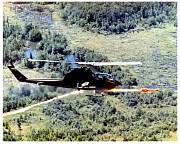
|
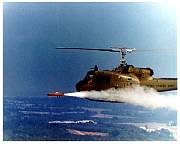
|
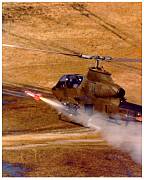
|

|
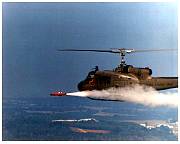
|
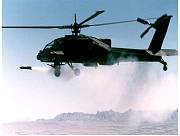
|
